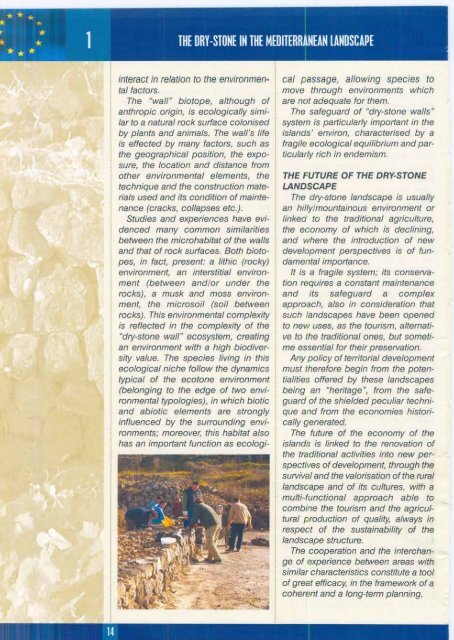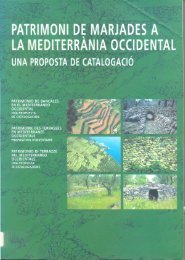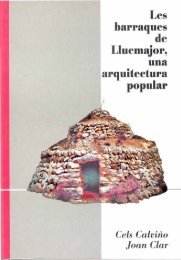La pedra en sec. Materials, eines i tècniques tradicionals a les illes ...
La pedra en sec. Materials, eines i tècniques tradicionals a les illes ...
La pedra en sec. Materials, eines i tècniques tradicionals a les illes ...
Create successful ePaper yourself
Turn your PDF publications into a flip-book with our unique Google optimized e-Paper software.
***<br />
*<br />
• * 1<br />
THE DRY -STONE IN THE MEDITERRANEAN LANDSCAPE<br />
***<br />
interact in relation to the <strong>en</strong>vironm<strong>en</strong>tal<br />
factors.<br />
The "wall" biotope, although of<br />
anthropic origin, is ecologically similar<br />
to a natural rock surface colonised<br />
by plants and animals. The wall's life<br />
is effected by many factors, such as<br />
the geographical position, the exposure,<br />
the location and distance from<br />
other <strong>en</strong>vironm<strong>en</strong>tal elem<strong>en</strong>ts, the<br />
technique and the construction materials<br />
used and its condition of maint<strong>en</strong>ance<br />
(cracks, collapses etc.).<br />
Studies and experi<strong>en</strong>ces have evid<strong>en</strong>ced<br />
many common similarities<br />
betwe<strong>en</strong> the microhabitat of the walls<br />
and that of rock surfaces. Both biotopes,<br />
in fact, pres<strong>en</strong>t: a lithic (rocky)<br />
<strong>en</strong>vironm<strong>en</strong>t, an interstitial <strong>en</strong>vironm<strong>en</strong>t<br />
(betwe<strong>en</strong> and/or under the<br />
rocks), a musk and moss <strong>en</strong>vironm<strong>en</strong>t,<br />
the micros oil (soil betwe<strong>en</strong><br />
rocks). This <strong>en</strong>vironm<strong>en</strong>tal complexity<br />
is reflected in the complexity of the<br />
"dry-stone wall" ecosystem, creating<br />
an <strong>en</strong>vironm<strong>en</strong>t with a high biodiversity<br />
value. The species living in this<br />
ecological niche follow the dynamics<br />
typical of the ecotone <strong>en</strong>vironm<strong>en</strong>t<br />
(belonging to the edge of two <strong>en</strong>vironm<strong>en</strong>tal<br />
typologies), in which biotic<br />
and abiotic elem<strong>en</strong>ts are strongly<br />
influ<strong>en</strong>ced by the surrounding <strong>en</strong>vironm<strong>en</strong>ts;<br />
moreover, this habitat also<br />
has an important function as ecologi-<br />
cal passage, allowing species to<br />
move through <strong>en</strong>vironm<strong>en</strong>ts which<br />
are not adequate for them.<br />
The safeguard of "dry-stone walls"<br />
system is particularly important in the<br />
islands' <strong>en</strong>viron, characterised by a<br />
fragile ecological equilibrium and particularly<br />
rich in <strong>en</strong>demism.<br />
THE FUTURE OF THE DRY-STONE<br />
LANDSCAPE<br />
The dry-stone landscape is usually<br />
an hilly/mountainous <strong>en</strong>vironm<strong>en</strong>t or<br />
linked to the traditional agriculture,<br />
the economy of which is declining,<br />
and where the introduction of new<br />
developm<strong>en</strong>t perspectives is of fundam<strong>en</strong>tal<br />
importance.<br />
It is a fragile system; its conservation<br />
requires a constant maint<strong>en</strong>ance<br />
and its safeguard a complex<br />
approach, also in consideration that<br />
such landscapes have be<strong>en</strong> op<strong>en</strong>ed<br />
to new uses, as the tourism, alternative<br />
to the traditional ones, but sometime<br />
ess<strong>en</strong>tial for their preservation.<br />
Any policy of territorial developm<strong>en</strong>t<br />
must therefore begin from the pot<strong>en</strong>tialities<br />
offered by these landscapes<br />
being an "heritage", from the safeguard<br />
of the shielded peculiar technique<br />
and from the economies historically<br />
g<strong>en</strong>erated.<br />
The future of the economy of the<br />
islands is linked to the r<strong>en</strong>ovation of<br />
the traditional activities into new perspectives<br />
of developm<strong>en</strong>t, through the<br />
survival and the valorisation of the rural<br />
landscape and of its cultures, with a<br />
multi-functional approach able to<br />
combine the tourism and the agricultural<br />
production of quality, always in<br />
respect of the sustainability of the<br />
landscape structure.<br />
The cooperation and the interchange<br />
of experi<strong>en</strong>ce betwe<strong>en</strong> areas with<br />
similar characteristics constitute a tool<br />
of great efficacy, in the framework of a<br />
coher<strong>en</strong>t and a long-term planning.




